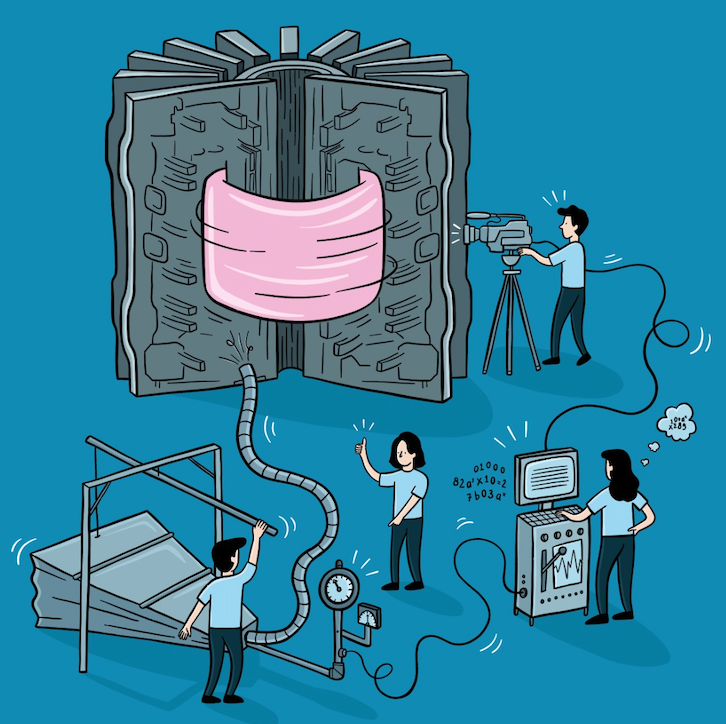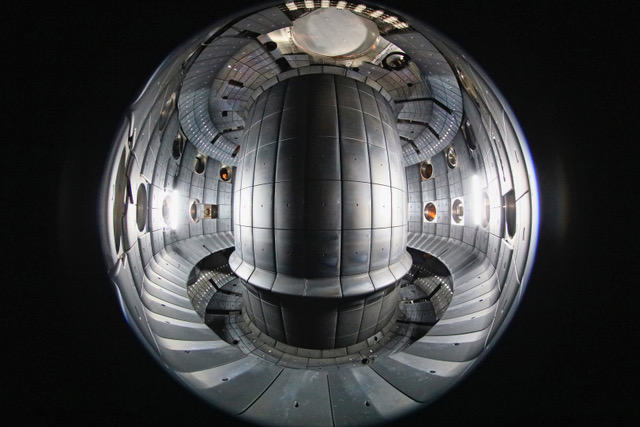The core of a fusion reactor is incredibly hot. Hydrogen that inevitably escapes from it must be cooled on its way to the wall, as otherwise, the reactor wall would be damaged. Researchers from the Dutch institute DIFFER and the EPFL’s Swiss Plasma Center have developed a strict measurement and control method for the cooling of very hot particles escaping from fusion plasmas. This milestone for fusion research is published in Nature Communications.

the tokamak wall from being destroyed. Credit: Julia van Leeuwen
“We are going from studying to controlling. This is vital for the future of fusion reactors,” says first author Timo Ravensbergen (DIFFER). “We measure, calculate, and control with incredible speed.” Fusion energy is a promising sustainable energy source. In a fusion reactor, extremely hot hydrogen plasma is kept suspended by magnetic fields. However, there is always a fraction that escapes. To prevent it from damaging the reactor vessel, the escaped hydrogen must be cooled down on its way to the wall.
Cooling can be achieved in various ways, such as by injecting a gas. "But if you inject too much additional gas, the plasma is cooled too strongly, which reduces the performance," says co-author Christian Theiler (Swiss Plasma Center, EPFL). It is therefore necessary to constantly manage the cooling to the point that the reactor can adequately cope. Matthijs van Berkel (DIFFER): “The ability to control the cooling precisely is explicitly stated in the European fusion program (EUROfusion) as a necessary step towards fusion energy. It is fantastic that we can contribute to this now.” In Nature Communications the authors describe how to cool the escaping particles in a quick and controlled manner with an innovative feedback control system. The experiments has been carried out in the TCV tokamak, a fusion research machine at the EPFL’s Swiss Plasma Center.
Done differently
Escaping hydrogen is carried away via the reactor’s ‘exhaust’. That exhaust is called the divertor, where the plasma heat losses are captured. The process of strong cooling in the vicinity of the divertor is called divertor detachment. It reduces plasma temperature and pressure near the wall. Fusion physicists already have a lot of experience with this process, but this is partly based on intuition and on experiences from previous measurements. Now things will be done differently.
“We have developed a closed system,” says Van Berkel, group leader Energy Systems & Control. “We have combined many different techniques, that is what makes it unique. Our systems engineering approach can be applied to other fusion reactors.” The experiments are a proof-of-principle. Van Berkel thinks that the method will be - with adjustments - applicable in the large fusion reactors ITER and DEMO.
Step-by-step
The researchers made use of the camera system MANTIS at the TCV tokamak for this research. This Multispectral Advanced Narrowband Tokamak Imaging System was developed by DIFFER, EPFL and MIT. The researchers adapted the system in such a way that camera images were converted into data from which a computer model could then calculate in real-time the optimum cooling under varying conditions. This all took place with considerable precision: the status of the plasma is determined 800 times per second.
A new real-time image-processing algorithm, developed at DIFFER, analyzes the MANTIS images. The algorithm calculates how much you need to cool by, and subsequently controls the gas valves automatically. Finally, the researchers produced a model of the system by analyzing, once again with the camera, how the plasma responds to the gas introduced. “With this model, we determine the dynamic relationship between the control of the gas valve and the heat front,” says Van Berkel.
Fast result: tested on TCV
The system was tested on the TCV tokamak. "It is a very flexible device, where ideas can be developed and tested rather quickly," emphases Theiler. Van Berkel agrees: “TCV is a fantastic machine for testing control techniques, with a hypermodern real-time control system.” Van Berkel tells results came fast: “Within just four experiments, we managed to achieve feed-back control of the plasma near the divertor. This demonstrates that our systematic approach works.”
Future research
A proposal for follow-up research has already been prepared. The researchers made use of just one MANTIS camera, whereas the system has ten. The researchers want to use the other cameras as well, so that they can control the process even more accurately, and to control additional key processes in the divertor.
Partners
This project is a collaboration between DIFFER, EPFL, Eindhoven University of Technology, Vrije Universiteit Brussel, MIT, Institute of Plasma Physics of CAS, CCFE, and the Max Planck Institute for Plasma Physics.
Reference
T. Ravensbergen, M. van Berkel, A. Perek, C. Galperti, B.P. Duval, O. Février, R.J.R. van Kampen, F. Felici, J.T. Lammers, C. Theiler, J. Schoukens, B. Linehan, M. Komm, S. Henderson, D. Brida, M.R. de Baar, The EUROfusion MST1 Team, and the TCV Team. Real-time feedback control of the impurity emission front in tokamak divertor plasmas. Nature Communications, 17 Feb 2021 - DOI 10.1038/s41467-021-21268-3

Go to the News page.